Buzzer 07 / Ninj Tumurkhuyag / Eric Parren
Context and significance
During our previous group research project, we explored how we could make an object and materials that are not interactive to be interactive by acting it out, and it helped us, my partner, to come up with materials that can actually be interactive when it’s combined with other conductive materials. As I mentioned, the finished project from the research did not align with my definition of “interactive”, therefore I tried to come up with a project that allows the user to interact in ways such as touching, listening and seeing how their action impacts the project. However, because buzz-wire games are the games that everyone has played with or heard of, we tried to make ours more significant by making the wires flexible instead of being fixed. By doing this, we wanted to make the game a customisable experience as the shape can be changed depending on what “level”, easy or difficult, the players want to play with. Our project Buzz 07 is for everyone as it is designed for a wide range of individuals and is intended to be enjoyed by people of all ages and backgrounds. The inclusive qualities of the project ensure that it can be engaging and entertaining for children, teenagers, adults, and even older individuals.
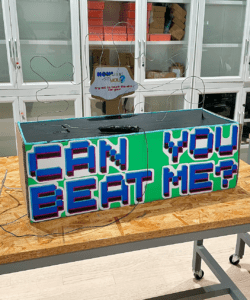
Concept and Design
When user testing, we found out people might require clear instructions to understand how the game works, even though we initially assumed the design would be self-explanatory. To clarify, I decided to include written instructions that would guide users through the gameplay process. Another design decision we made was related to the placement of the LED. We wanted people to focus on not touching the wires without any distractions so we placed a small red LED behind the wire rather than placing it in front of it.
Regarding the choice of materials and elements of the wire, as we received feedback on how the wires needed to be a bit thicker for more stability, we changed the wires to thicker wire but not too thick for flexibility because I think it adds an interactive element, enabling users to physically manipulate the wires.
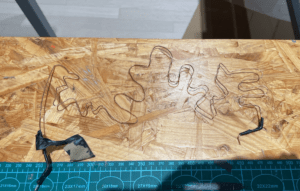
Fabrication and production
Firstly, we started by sketching out and discussing the design and materials we wanted to use for our project. This initial brainstorming phase helped us visualize the final product and set the foundation for our work. Next, we built a smaller demo version of the project to test the circuit and ensure that everything was working correctly. This step was crucial in identifying any technical issues or flaws in the design and it allowed us to make necessary adjustments and improvements before going further. Therefore, during the User Testing Session, we received a lot of feedback from users saying it was difficult to play and suggested making it larger and more stable. The feedback prompted us to reevaluate the size and stability of the wire and make solutions for the concerns.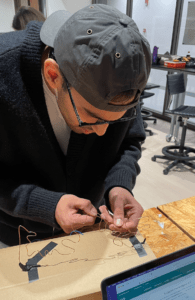
In terms of personal contributions, I took on the responsibility of coding, building the circuit, and working on the overall design and decoration of the project. I focused on ensuring that the code was working and responsive and that the circuit components were properly connected. I also worked on enhancing the aesthetic appeal of the game to make it visually appealing and engaging for users.
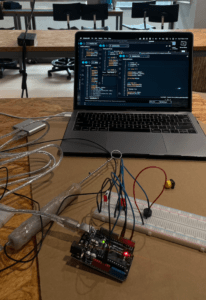
One of the major production choices we made was the inclusion of additional features such as a timer, speaker, and multiple LEDs. However, based on user testing feedback, we decided to streamline the game by including only one LED to avoid distracting users from the main objective. This decision was effective in simplifying the game and allowing players to focus on the core gameplay. Thus, we prioritised functionality over complexity and our main goal was to create a game that actually worked and provided an enjoyable user experience.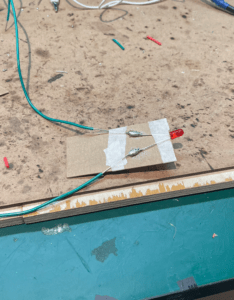
Coding:
int button = 2; int orangeLED = 6; int buzzer = 7; void setup() { pinMode (buzzer, OUTPUT); pinMode (orangeLED, OUTPUT); pinMode (button, INPUT); Serial. begin (9600); } void loop() { button = digitalRead (2); Serial.println(button); if (button == 1) { digitalWrite(6, HIGH); tone(buzzer,3000,700); } else { digitalWrite(6, LOW); noTone(buzzer); } }
Conclusion
In conclusion, the goals of our project, Buzz 07, were to create an interactive game that allowed users to touch, listen, and see how their actions impacted the gameplay. However, there were some aspects of our project that did not fully align with our definition of interaction. For example, we initially planned to include additional features like a timer, speaker, and multiple LEDs, but due to feedback from user testing, we decided to simplify the game and focus on the core gameplay experience. If we had more time, we would further refine the aesthetic design to make it visually appealing and engaging.
From setbacks and failures encountered during the production process, we have learned the importance of user feedback and the need to iterate and adapt based on that feedback. We successfully incorporated physical interaction, immediate feedback, and customization into the gameplay experience, aligning with our project goals. We also developed skills in coding, circuitry, and design, enhancing our abilities in creating interactive projects. While our project aligned with our definition of interaction in many aspects, there were areas where we had to make adaptations based on user feedback. Through this process, we learned valuable lessons and gained a deeper understanding of user preferences and the importance of iterative development.